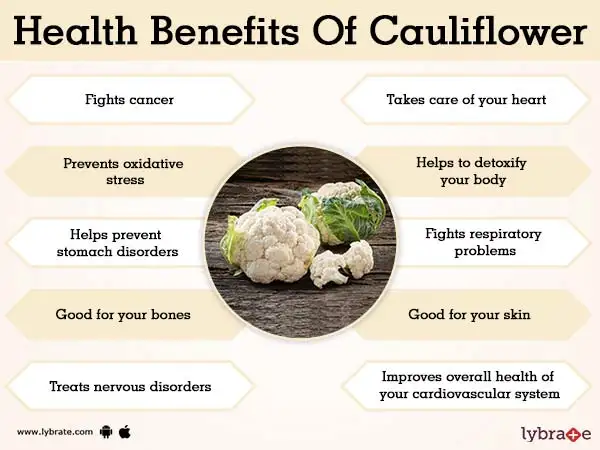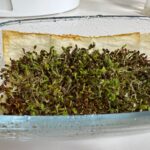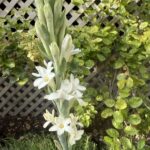The Cauliflower is a versatile vegetable that is equally loved in both Eastern and Western cuisine. It is quite flavourful even with a minimum of seasoning and not so hard to grow during the season in the Gulf. What it does need is a lot of water so that large heads are formed.
Cauliflower gets its name from the Latin Caulis which means “Cabbage with a flower”. Like Broccoli and Cabbage, it belongs to the Brassicaceae family. The Cauliflower has florets on its head which are also known as curd. They are tightly clustered and consist of immature flower buds attached to a central stalk.
Cauliflowers are protected from the sunlight to prevent development of the chlorophyll pigment and over-maturity. This protects the flavour and softness of the heads. It is a great source of Vitamin C, the “B” vitamins, and Potassium.

This is the one in the pot. See how well it is doing. The next one is in a bed near trees.

The best time to sow seeds is in late August or early September depending on the temperature. Plant in peat pots or paper cups so replanting is easier. Make sure each pot has only 2 seeds at the most. Cauliflower seeds have a germination rate of 50-70% generally, so check the seed packet for germination rates before you sow. It takes 8-10 days for the seeds to germinate. Using a humidity dome is normally helpful in aiding germination. Once the true leaves are out you can bury the peat pot in a larger pot so that the roots have space to grow. After approximately 43 days it is ready to be planted in its final home.
My experiment this year was to plant in pots as well as in the ground. I found that the plants in the ground were not doing well as they had less sun and competition for water from the trees around them. The ones in the pots did really well. Therefore, I recommend using planter boxes or a bed away from big trees which get about 4-6 hours of sun.
Before transplanting, amend the soil with a generous amount of cow manure and vermicompost. Initially, they need more nitrogen but later we need to give them a liquid fertilizer rich in potassium when the heads begin to form. Also, make sure you have soil that holds water so we might need to use a wee bit more sweet sand in the mix. Make sure you water every day in the Gulf even in winter. At approximately 112 days from planting the seed the heads will start to form. At this point, cut off a few of the lowest leaves.
Now we could add potassium-rich fertilizers like banana peel water, Fruit Ferment Juice Etc. Using EM is also great at this point as it helps in increasing the size of the head.
You can harvest around 126 days depending on the weather and the size that you want of the head. Remember to make sure the head is not coming apart as that shows that the cauliflower is close to seeding. You need to harvest when the heads are still tightly held together. Normally you should be able to harvest around mid-February if you planted in September end. Remember that after you harvest the first head there is a possibility of a couple of smaller ones coming through during March so don’t throw away the plant.
As for pests they do get attacked by caterpillars and spider mites. But treat organically regularly and you should be fine.
Two tips if you are using raised beds or planters. The depth need not be more than 18 inches as the roots are quite shallow. Also, if planting in a row make sure you plant the tiny saplings at least a foot away from each other as they do grow horizontally as well. So, calculate the number of saplings as per the length of your planter.
Finally, if you want to know the health benefits of Cauliflower, here is a summary.

Good luck!







One Response
I truly appreciate this post. I’ve been looking all over for this! Thank goodness I found it on Bing. You’ve made my day! Thank you again!